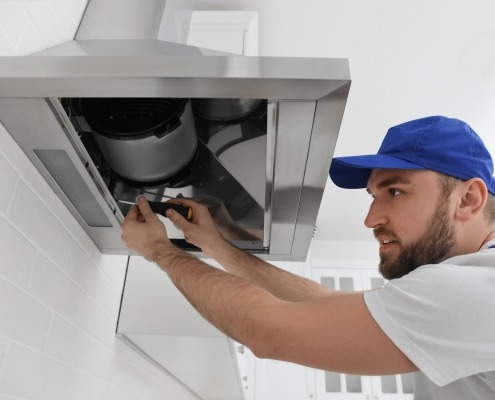How to test the main control board on a Samsung range
Steven E / Friday April 4, 2025
Is your Samsung range causing culinary chaos with unexpected malfunctions? If the control board—the heart of your range’s electronic operations—is on the fritz, it might be time for a checkup. Our step-by-step guide, complete with a detailed how-to video below, will empower you to troubleshoot and restore your appliance’s functionality, ensuring your kitchen remains the hub of delicious creations.
Looking for the right part? Enter your appliance model number below to find the exact match and get your appliance running like new again!
When your Samsung range starts acting up, the culprit could be a faulty main control board. The control board is the brain of your range, responsible for managing all the electronic functions. Properly testing the control board can help you determine if it needs to be repaired or replaced. Let’s dive in and get your Samsung range working like new.
If you find out that you need any replacement parts for your appliance, you can enter your model number at AppliancePartsPros.com to order them. Most orders arrive in just two business days, and we have thousands of free guides to show you how to install your new parts.
Watch here: How To Troubleshoot A Samsung Range Main Control Board
Tools and materials
- Phillips head screwdriver
- Multimeter
The specific tools required may vary depending on the model of your appliance and the type of fasteners used on it. Always consult the user manual or refer to any specific instructions provided by the manufacturer for the recommended tools for your appliance model.
Safety precautions
When working on any appliance, remember to keep safety first. Here are some tips to keep in mind:
- Always power off and unplug your appliance or switch off the circuit breaker before attempting any maintenance or replacement work. This keeps you safe by preventing any risk of injury from electric shock.
- Wear insulated work gloves to protect your hands from sharp metal parts, pinching hazards and debris.
- Take your time and don’t rush while working to prevent accidents and personal injuries.
- Work in a well-lit area so you can clearly see and access the interior parts.
- Clear your workspace of clutter and other obstacles. Keep children and pets away from the work area.
- Never work on internal parts with bare wet hands. Make sure the work area is completely dry.
- Check your user manual to see if there are specific installation or safety instructions for your part or appliance.
- Be gentle when handling or removing parts. Excessive force might damage the appliance or cause injury.
- Wear safety glasses when working with chemicals, dust or cleaning large debris to prevent injury.
- If the appliance has recently been used, give it plenty of time for any heating parts to cool down before working on it.
- Take pictures or make a note of wiring terminals or other connections before disconnecting to prevent any problems with reassembly.
- When working with wires, avoid touching any exposed wires or terminals. If you need to touch a wire, use a non-conductive tool or wear insulating gloves to prevent electrical shock.
Testing steps
Disassembly:
- Slide the range out from the wall and remove the rear cover on the top back of the control panel. You’ll need to remove several Phillips head screws to do this.
- Locate the different connection points for each part that the main control board controls.
- Look for a number next to each connector on the board to identify them.
- There are 8 connectors total on this specific control board.
Testing the ribbon CN07 connector:
- The CN07 connector is for the ribbon cable to the keypad, located on the far left side.
- Check that the ribbon cable is connected properly and inspect the connector for any damage.
Testing the relay control board CN04 connector:
LIVE VOLTAGE WARNING: For this test, the appliance needs to be plugged in and powered on. Please be very careful to protect yourself from electric shock, which has the potential to cause serious injuries. Don’t ever test live voltage if you’re uncomfortable using a multimeter.
- The CN04 connector is one of two that goes between the main control board and the relay control board, located on the far left bottom.
- With the range plugged in and powered on, use a multimeter to test between the orange and blue wires – you should get 4.7VDC.
Testing the relay control board CN05 connector:
- The CN05 connector is the second connector between the main board and relay board, to the right of CN04.
- With a multimeter, test between the black and white wires – you should get 3.85VDC.
- Unplug the range before proceeding to the next test.
Testing the oven sensor CN02 connector:
- The CN02 connector is the third from the left, with blue and yellow wires.
- Set the multimeter to measure resistance and test between the CN02 wires.
- At room temperature (77°F), you should get 1,080 ohms.
- At 200°F, it should be around 1,360 ohms.
Testing the door lock assembly CN01 connector:
- The CN01 connector is the fourth from the left on the bottom, with green, pink, brown, blue, and violet wires.
- Test for continuity between pins 4 and 5.
- With the door closed, test for continuity between the brown (pin 6) and orange (pin 7) wires.
Testing the power supply CN09 connector:
- The CN09 connector is on the bottom right, where the power supply enters the board.
- With the range powered on, use a multimeter to test 120VAC between the black and white wires.
Testing the low voltage transformer CN08 connector:
- The CN08 connector is just above CN09, for the low voltage transformer.
- Test 120VAC between the two white wires.
Testing the display CN10 connector:
- The CN10 connector is in the middle on the right, for the display.
- Test 13.5VAC between the two red wires.
- Test 8VAC between the two yellow wires.
If all test results are good, the control board is functioning properly. Any failed tests indicate a faulty control board that needs replacement.
Additional information
Thank you for reading! We hope this guide helped you get your Samsung range working again.
If you have any other appliance repair needs or projects, don’t hesitate to explore our other troubleshooting guides and videos.
If you need replacement parts or some extra help with ordering them, grab your model number and head over to AppliancePartsPros.com, where you can chat with a pro, read our DIY blog and more.
Don’t forget to subscribe to us on YouTube and follow us on Facebook, Twitter and Instagram!
With nearly a decade of experience in providing top-notch customer service regarding appliance parts and repair, Steven enjoys sharing practical advice, troubleshooting tips, and interesting information to help readers stay informed.





